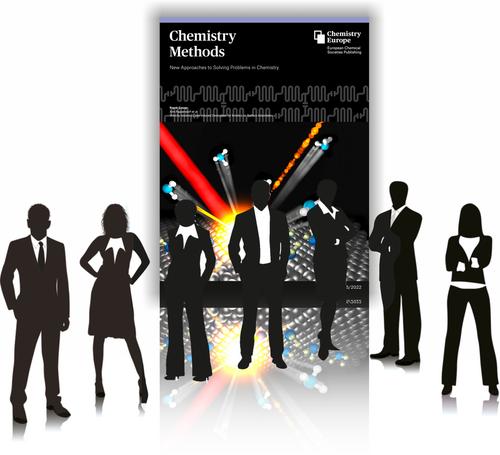表面吸附动力学的速度分辨激光诱导解吸
IF 6.1
Q1 CHEMISTRY, MULTIDISCIPLINARY
Chemistry methods : new approaches to solving problems in chemistry
Pub Date : 2022-05-02
DOI:10.1002/cmtd.202200028
引用次数: 0
摘要
应邀担任本月封面的是德国Göttigen乔治-奥古斯特大学和希腊克里特岛大学的Alec M. Wodtke小组。封面图片显示氨(NH3)分子吸附在原子平面铂表面。一个超短激光脉冲击中金属表面,在100秒内迅速将金属电子加热到几千开尔文。这种高电子温度导致一小部分氨分子以超热速度从表面解吸。取决于激光强度,解吸分子的数量与表面覆盖率成正比。阅读他们的研究论文全文:10.1002/cmtd.202200017。本文章由计算机程序翻译,如有差异,请以英文原文为准。

Velocity-resolved Laser-induced Desorption for Kinetics on Surface Adsorbates
Invited for this month's cover are the groups of Alec M. Wodtke at the Georg-August University in Göttigen (Germany) and at the University of Crete (Greece). The cover picture shows ammonia (NH3) molecules adsorbed on an atomically flat platinum surface. An ultra-short laser pulse hits the surface and heats up the metal electron rapidly to several thousand Kelvin within a few 100 fs. This high electronic temperature causes a fraction of the ammonia molecules to desorb with hyperthermal velocity from the surface. Depended on the laser intensity, the number of desorbing molecules is proportional to the surface coverage. Read the full text of their Research Article at 10.1002/cmtd.202200017.
求助全文
通过发布文献求助,成功后即可免费获取论文全文。
去求助
来源期刊
CiteScore
7.30
自引率
0.00%
发文量
0

 求助内容:
求助内容: 应助结果提醒方式:
应助结果提醒方式:


